back to back mechanical seal manufacturer
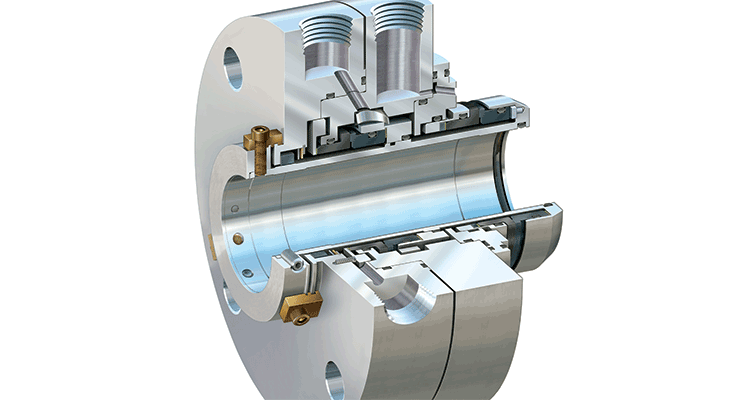
In Part 2, we’re taking a closer look at the various rotary and stationary double seal arrangement options (configurations), and how to maximize their success.
A double seal is designed with two primary seals. These seals often use two rotating seal faces and two stationary seal faces. A fluid is provided between these two seals at a lower pressure than the sealed fluid (known as buffer fluid) or at a pressure higher than the sealed fluid (known as barrier fluid). The fluid provided to the dual seal allows the seal to survive in lethal, explosive, carcinogenic, hazardous, adhesive, or extremely viscous fluids.
A conventional double seal can be designed to seal the buffer or barrier fluid on the inside or outside diameter of the seal faces. Typically, the seal designer will place a softer, narrow face against a harder, wide seal face. The design intention is to enable the softer seal face to wear, while keeping the wider hard face from wearing in service. Once the narrow seal face has been worn away, the seal has reached the end of its suitable life.
Each configuration has its own strengths which are addressed below. Ultimately, it’s best to speak with a sealing specialist who can draw on a wealth of direct experience and implement according to your organizations’ expectations for reliability and environmental compliance.
In this double seal configuration, two narrow seal faces are mounted back-to-back (opposing) to one another. This is the original concept of a dual seal —taking two component mechanical seals and placing them ‘back-to-back’ within the stuffing box. This configuration is used in most general applications.
The unbalanced back-to-back mechanical seal requires a barrier fluid pressure of 15 psig higher than the seal chamber pressure. The barrier fluid is being pressurized above the seal chamber pressure, so the outboard seal faces are carrying the greater load and should wear out or fail first. When this happens, the barrier pressure will be lost, causing the inboard faces to open. In other words – if the seal works correctly, both seals will fail at the same time. This is not very good back-up protection.
If this seal is a double balanced design, the fluid between the inboard and outboard seal faces can be higher (barrier) or lower (buffer) pressure than the seal chamber pressure. This means that if the barrier/buffer fluid is lost, both seals will remain closed and operate reliably.
In back-to-back arrangement (both unbalanced and balanced seal designs), the outboard seal faces almost always are rated for a lower pressure than the inboard seal faces. This is because the outboard seal faces are an outside seal configuration and the faces are exposed to tensile force. Ceramics are generally weaker in tension than compression, so their pressure limit is lower.
If the inboard seal fails first, the barrier fluid will leak into the process which will cause product dilution. This product dilution sometimes is not desirable for products that can not tolerate it.
This configuration occurs when two sets of seal rings are identically orientated and mounted in-series. This configuration is often referred to as the “in-series seal face arrangement” or “face-to-back.” It is commonly used in dual seals.
In this arrangement, the seals position the barrier or buffer pressure on the outside diameter of the outboard face. The pressure acts to compress the outboard seal faces. This allows a higher barrier fluid pressure.
Face-to-face seals can be used when the equipment is space constrained to accommodate a back-to-back or tandem seal arrangements. In this configuration a portion of the seal is mounted in the seal chamber and the remainder is mounted outside of the seal chamber.
For successful seal life and reliability it is very important to have the right seal arrangement along with the right barrier/buffer fluid system. In upcoming blogs, we will discuss various seal environmental control plans available for double seals and how to select the best barrier / buffer fluid for good seal life to achieve maximum reliability.
Antim Parikh is a Special OEM Projects & Applications Support Manager at A.W.CHESTERTON for mechanical seal product line. He manages the group of mechanical seal applications engineers and OEM platform products/projects.
Antim has worked for the A.W. Chesterton Company for the last six years in the Mechanical Seal product line as Lead Applications Engineer. He has provided support to all field salespeople and customers on product recommendation and troubleshooting. He has also conducted numerous mechanical seal training classes for customers and distributor’s specialists to provide assistance to training group.
Antim holds degrees in Master of Science in Mechanical Engineering (Fluid Power) from CT, USA and Bachelor of Science in Mechanical Engineering from India.
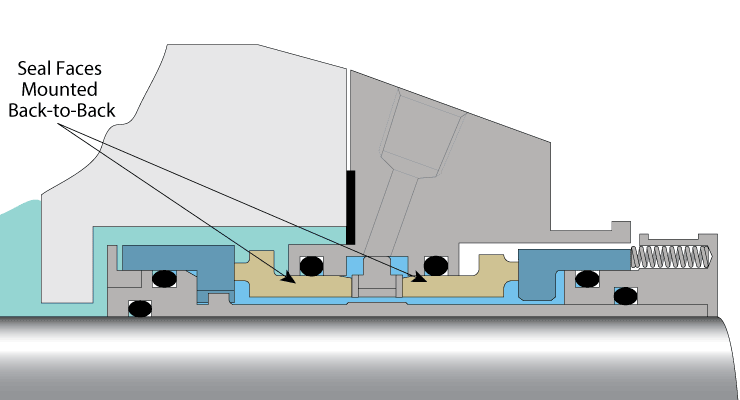
The scope of our mechanical seal product range far exceeds any other seal manufacturer. From small elastomer bellows seals used in millions of domestic water pumps to double mechanical seals that ensure maximum sealing safety and large, highly customized dry-running gas seals for mission critical high speed turbo compressors, John Crane has the right product for any application.
Our world-class rotating equipment technologies, paired with an unmatched breadth of applied engineering expertise, meet virtually all international standards including API 682 and help plants reduce maintenance costs, slash down time and improve reliability. When it comes to keeping your rotational equipment running 24/7, John Crane’s comprehensive range of mechanical seals and systems has you covered.
A range of seals for mission-critical applications, designed to solve the application-specific challenges of each industry. From API 682 compliance for the oil and gas industries, using gas seal technology on our innovative pump gas seals to eliminate fugitive emissions, dealing with slurry in the mining and minerals processing industries, to the difficulties associated with maintenance on large pumps and rotating equipment — we have a solution.
Dry-running, non-contacting gas seals have been the industry standard since the early 1980s for turbomachinery. John Crane gas seals, separation seals and support, monitoring, control and conditioning systems — the heart of any reliable sealing solution — are constantly evolving to meet the needs of customers. The product portfolio is supported by unrivaled global service capability providing repair, retrofit, gas seal storage and reliability expertise, delivering total solutions throughout the product lifecycle.
In industries like chemical, pharmaceutical, pulp and paper, and food and beverage, safeguarding and compliance with industry standards, avoiding contamination and efficiency are always top priorities. Our range of vessel and agitator seals optimize equipment performance, maintain product purity and conform to industry regulations, no matter where you are.
Our range of mechanical seals, packing and bearing isolators combines advanced, thoroughly proven technologies with extensive industry expertise to create a range of products characterized by innovative design concepts and outstanding manufacturing quality. Tried, tested and effective solutions for virtually any application that deliver robust performance, reduced installation times and lower maintenance costs.
Create the optimum operating environment that will ensure outstanding seal performance and reliability. Our comprehensive range of engineered pressure reservoirs, gas seal control panels, heat exchangers and abrasive separators can be combined to produce the perfect seal support system for any application.
Designed to overcome rigorous challenges, our comprehensive suite of seal face technologies combat limited seal face lubrication that adversely affects reliability, cost and durability. Our engineers designed these face treatments to extend rotating equipment life through advanced micro machined patterns and features improving seal face lubrication that optimizes equipment performance. We deliver the right face technology for the right application.

Dual cartridge seals, also referred to as double cartridge seals, are the answer for applications where a second level of protection is needed due to risks to the environment or operating equipment. Flexaseal offers a variety of models that are easy to install while also complying with environmental regulations and ANSI standards. A variety of configurations are available depending on the application and operating conditions.

Flexaseal has replaced traditional cup point set screws with stainless steel drive lugs, resulting in a five-fold improvement in torque transmission strength. And the possibility of sleeve distortion and damage due to over-tightened set screws is eliminated
Note: Max Temperature / pressure / speed indicate operating extremes independently and do not imply the seal will function at these extremes at the same time. Contact Flexaseal Engineered Seals and Systems, LLC if in doubt.
Depending on your specific needs and application, Flexaseal can help you identify the ideal products. Contact us to tell us about your needs and request a quote.
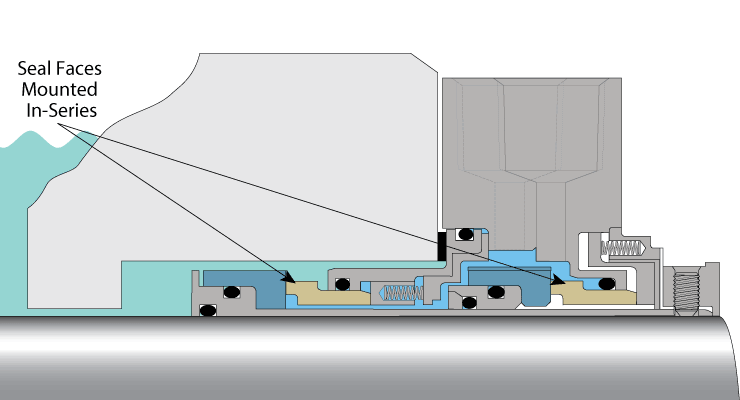
A.W. Chesterton® is a manufacturer of industrial fluid sealing and maintenance products including hydraulic seals, pneumatic seals, mechanical seals and packing, oil seals, o-ring seals, metric seals, lip seals and many other products. We are ISO 9001/14001 and MRP II Class A certified.
AccroSeal® is committed to manufacturing high quality seals to your design at competitive prices. The AccroSeal® technical sales team works directly with your engineering department to solve the most difficult sealing applications. Our sealing product portfolio includes wipers, lip seals, o-rings, piston rings, v-rings, and more produced from our exclusive Accrolon® engineered compounds.
American High Performance Seals Inc. designs and manufactures hydraulic seals, rotary shaft seals, oil seals, gaskets and other high performance rubber and plastic parts. AHP Seals designs and manufactures the most durable seals available and delivers them within 1-4 days.
Since 1981, American Seal Supply Co. has been distributing top-quality fluid seals and packing to its varied customer base. Among our product offerings are oil seals, rubber seals, o-ring seals, metric seals, Teflon® seals and lip seals. We also supply hard-to-find and custom-made seals.
American Seal & Packing is a leading manufacturer & distributor of mechanical seals, Grafoil, gasket material, cut gaskets and quality o-rings. We are constantly working to provide innovative solutions to mechanical seal problems. With our wide selection of products we"re finding better ways to serve our customers all the time. Contact our expert staff for a quote to meet your needs.
Appleton Packing and Gasket was born out of the need for better service. Among the many products we offer are mechanical seals, oil seals, gaskets, mechanical packings and o-rings. We attribute our success to the trust placed in us by our customers. Our continuing goal is to offer outstanding quality products at competitive pricing, in a manner which will best satisfy customer needs.
Beacon Gasket & Seals Co. is fully tooled to cut your requirements from compressed non-asbestos, gylon, gore-tex, flexible graphite, teflon, silicone, red rubber and neoprene rotary seals and other hydraulic sealing systems. Specializing in MTBF Solutions and representing the best manufacturers in the industry, we are excited about our expanding product offerings and the opportunity to serve you.
CoorsTek provides custom engineering, materials expertise, operational excellence and rapid execution to make our world measurably better! Technical ceramic, engineering plastic and specialized metal components help us build tomorrow’s technology. CoorsTek hydraulic seals offer extreme-temperature, high-pressure, chemically inert, static and dynamic seals for the most demanding applications.
CW Marsh offers you the best of both worlds: the toughest, most versatile natural material available for sealings and the benefits of a century of technological advancements and product innovation. CW Marsh produces leather vee packings, cups, u-packings, flanges, and back-up washers, all manufactured and backed with the same old-world dedication to quality, service and dependability.
At D&D Engineered Products Inc. we manufacture top of the line hydraulic seals, gaskets, various o-rings, high temperature tapes, compression packings, and much more. We promise to cater our product to any needs you may have, such to ensure your satisfaction. If you would like more information please give us a call.
East Texas Seals, Inc. is a distributor of O"Rings and Gaskets for Parker Seal. If you need an O"Ring, Seal or Gasket, we can fulfill your needs. We have supplied the Oil Field industry with O"Rings to adequately keep their oil rigs up and running. East Texas Seals, Inc. works closely with the U.S. Government and Defense departments, shipping and storage companies and all commercial sectors.
EPM, Inc. is your one stop shop for seals, with billions of styles including rod seals, piston seals, symmetrical seals, V-Rings, wipers, rotary shaft seals, wear rings, static seals, back-up rings, o-rings, buffer rings, u-cups, oil & grease seals, cast iron piston rings and gaskets. Whether you need one or one million, EPM offers fast turnaround and great prices on seals up to 21inches or 600mm.
With an extensive customer service center for catering to customer needs, Freudenberg-NOK manufactures a number of different seals. These offerings include hydraulic seals, pneumatic seals, o-ring seals, rod seals, piston seals and pump seals.
Garlock Sealing Technologies is the global leader in high-performance fluid sealing products for the world’s processing industries. Their 12 manufacturing facilities in the U.S., Canada, Europe, Asia and Latin America collectively produce the broadest range of fluid sealing products designed specifically for industrial applications. Some products include metal gaskets, o-rings and oil seals.
Here at Gasket & Seal Fabricators, we supply die cut, lathe cut, extruded, molded and spliced gaskets of all types, sizes and shapes. We specialize in both commercial and military spec materials, including many UL, FDA and NSF recognized materials. Our in-house capabilities include various types of die cutting equipment such as punch presses, both manual and automatic roll feed, clicker presses, and beam presses. Contact us for more information!
We manufacturer high quality hydraulic seals that are ideal for a wide range of industries. Here at Global O-Ring and Seal, LLC we are a trustworthy manufacturer who is known for our ability to adhere to all of your special requests. These seals come in a number of different materials including Buna, Viton, Silicone, Teflon, Aflas and more. Please give us a call today to learn more!
Greenville Industrial Rubber & Gasket is your source for industrial rubber products and accessories. For over 35 years, we have been providing the industry with top-quality rubber products including: gaskets, conveyor belts, packing, hoses, industrial hose fittings and hydraulics. In addition to industrial rubber products, we also stock a wide selection of safety products, adhesives, and other accessories.
We are a preferred supplier to most of the leading global manufacturers of hydraulic equipment, air compressors, transmissions, hydraulic clutches, valves and shock absorbers. We manufacture hydraulic seals and pneumatic seals among other products. Let us work together to enhance your applications.
Over 100 years, Hallite Seals International has been at the cutting edge of fluid power technology, manufacturing a wide range of rod / gland, piston, and static seals, as well as support and bearing components, for technically challenging applications, from a wide range of materials which include Polytetrafluoroethylene (PTFE), Polyurethane (AU), nitrile rubbers (NBR) and Fluoro-elastomers (FKM).
For over 34 years, Harwal has continued to be the leader in metric oil seals. With one of the largest seal selections, 1,000,000 seals in 7,000 different sizes in stock, be assured we"ve got what you need. We also offer V-rings, standard inch sizes, end caps, Teflon® seals, wipers and gamma seals!
For over 34 years, Harwal has continued to be the leader in metric oil seals. With one of the largest seal selections, 1,000,000 seals in 7,000 different sizes in stock, be assured we"ve got what you need. We also offer V-rings, standard inch sizes, end caps, Teflon® seals, wipers and gamma seals!
Hi-Tech Seals is capable of either creating parts with our in-house machining department or utilizing our relationships with industry leading seal manufactures. Our sales staff works with customers to find the best solution to replicate existing or design new parts. Different manufacturing options include machining, molding and extrusion.
At HydraPak, we make replacing your hydraulic seals easy, so you can get your seal repair jobs completed quickly, saving you time money. Even the most difficult seal repair challenges can be handled by our knowledgeable staff to get your equipment. We offer expertise in products for high-tech applications, as well as the ability to source everything from o-rings to sheet goods to sealing devices.
Being a seal manufacturer and distributor, JEM Seal Co. offers mechanical seals, hydraulic seals, oil seals, rubber seals, and more. Our mining equipment industry seals are used exclusively by Hallite Mining. Our stock of piston seals, rod seals, and wipers are in stock for your specific needs.
Encapsulated O-ring manufacturer and Precision extruder M-Cor Inc. is a leading U.S. producer of high performance sealing products for extreme environments. Extruded profiles are converted into o-rings, Teflon® encapsulated o-rings, camlock gaskets, chemical transport tubing and other sealing products. With in house tooling capabilities, we are able to immediately respond to customer requests.
Martin Fluid Power distributes on a worldwide basis, hydraulic seal repair kits, o-ring seal repair kits, metric seals, Teflon® seals and a lot of other types of seals, plus gaskets and packing. Our products come in many different shapes, sizes, materials and colors to suit your specifications.
Speed is of the essence at Michael-Stephens Co. Within 24 hours of your request, we can customize nitrile oil seals for you in a variety of profiles and materials. We work with a wide range of Teflon®-filled items. We also supply hydraulic seal kits; our website lists the wide range of manufacturers we carry.
Pacific International Bearing is capable of providing solutions for all types of applications with an educated and committed staff here to service your needs. PIB offers quality seals from Chu Hung Oil Seals Industrial Company (manufactured in Taiwan). They hold ISO 9001 Quality Certificates to provide top quality oil seals. Seals come in a variety of sizes and lip designs to suit your need.
With over 175 years of accumulative sealing experience, this team has helped pioneer the development of high performance seals around the world. Our core people excel at innovative seal design, high performance materials utilization, and efficient production techniques with a Certified ISO 9001: 2000 and AS9100 Rev. Some products of ours include, rotary shaft, rod and piston seals.
We are not only technically knowledgeable about hydraulic seals, but we also have the hands-on experience to back it up. We have over 30 years of industry experience, and we can use that experience to benefit you. We have faced nearly every problem and know the right solution for most problems. We can offer both stock and custom seals to benefit you. We will always put the customer first, so contact us today!
R&B Plastics is a supplier of custom machining serving a variety of industries including electronic connectors, plastics, filters, bearings, hydraulics and valve seals. With 34 years experience, R&B Plastics provides quality products to both the U.S. Government and major aerospace companies such as Boeing Corporation.
R.T. Dygert International is one of the largest distributors located in Minneapolis, MN and an office/warehouse in Niles, IL. RT/Dygert International prides itself on its responsive, service-driven culture and its reputation for its core values of quality, honesty and integrity and committed to a process of continuous improvement. Some of the products include piston and rod seals and o-rings.
Seal Master® specializes in manufacturing custom-built inflatable seals. These products include metric seals and rubber seals available in different sizes and shapes. Our seals are used in a wide variety of applications, including valves, robotics, conveyors, gates, brake devices and actuating devices.
Established in 1979, Southwest Seal and Supply has grown to become one of the most predominant distributors of sealing, hydraulic hoses, fittings, couplings/connectors, gasketing and fluid control products in the Southwest. We offer a wide range of products including the best in selection, quality, and value-added services.
System Seals offers a complete range of industrial hydraulic seals: small or large diameter, low or high pressure, reciprocating or rotary motion, dynamic or static sealing. We carry in-stock standard sizes plus are flexible enough to cater to all sizes. Rod Seals, Piston Seals, wipers & guide elements.
The T-Bird Group is a collection of distributors and manufacturers of seals, bearings, v-packings, unified pistons, wear rings, wipers, wear strips, u-cups, and machined plastic components.
Texacone Company, Inc is a manufacturer of fabric-reinforced elastomer and urethane molded products. Texacone specializes in molded seals up to 65" diameter in solid or split from a wide variety of fabric-reinforced elastomers. High temperature materials also available. Some of our products are: v-rings, flared u cup, piston cups and flanges.
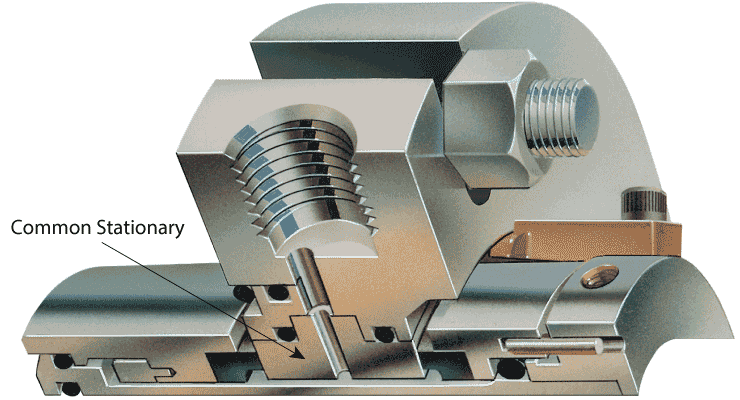
This website is using a security service to protect itself from online attacks. The action you just performed triggered the security solution. There are several actions that could trigger this block including submitting a certain word or phrase, a SQL command or malformed data.
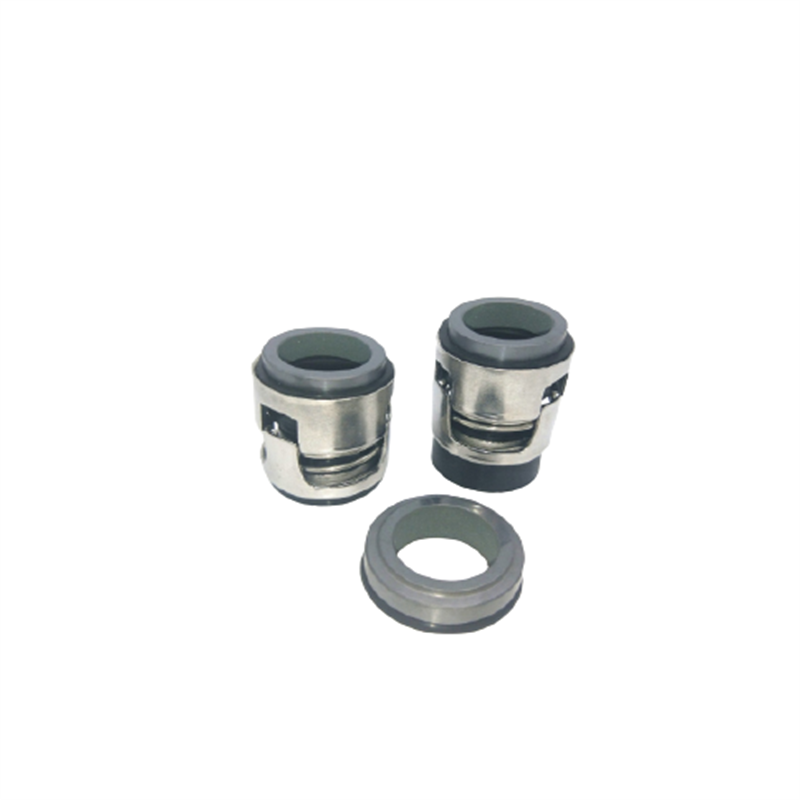
Although it is not the millwright or mechanics responsibility to specify mechanical seal applications, it is a good idea to have a basic understanding of their purpose. This blog will give the basics of double and tandem mechanical seals.
The double mechanical seal uses two mechanical seals (an inboard and outboard seal). They can be installed back to back, front to back or front to front depending on the application. Double seals are used when leakage of pumped fluid to the atmosphere is not allowed.
Tandem seals are two single seals mounted in the same direction. Tandem seals are used for toxic or flammable liquids that require a buffer or safety zone. If the inboard seal fails, a high pressure alarm will activate to provide a warning that the inboard seal has failed. A tandem seal with an inboard seal failure no longer has an effective safety zone.
For more in depth information on mechanical seals, I highly recommend contacting your mechanical seal supplier. They are usually very willing to help.
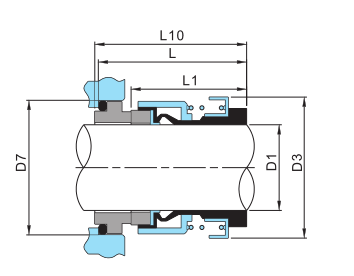
This website is using a security service to protect itself from online attacks. The action you just performed triggered the security solution. There are several actions that could trigger this block including submitting a certain word or phrase, a SQL command or malformed data.
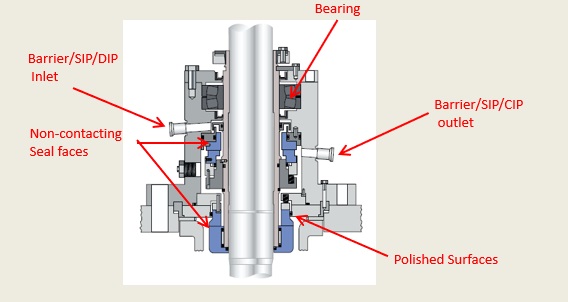
This website is using a security service to protect itself from online attacks. The action you just performed triggered the security solution. There are several actions that could trigger this block including submitting a certain word or phrase, a SQL command or malformed data.

This website is using a security service to protect itself from online attacks. The action you just performed triggered the security solution. There are several actions that could trigger this block including submitting a certain word or phrase, a SQL command or malformed data.

When you need a repair or replacement for your damaged mechanical seals, there are a number of excellent reasons to choose Gaddis Inc. With over forty years of experience in the mechanical seal repair industry, our team of engineers and technicians have the knowledge and experience required to tackle any mechanical seal repair project. This expert team, combined with our state-of-the-art facility and cutting-edge equipment, allows us to offer some of the highest quality mechanical seal repair services that you will find on the market today.
The reasons to choose Gaddis Mechanical Seals for all of your mechanical seal repair needs don’t stop there. In addition to providing unparalleled mechanical seal repairs, we at Gaddis Inc. also strive to keep our rates as competitive as possible. By leveraging our numerous, long-standing relationships with our various suppliers and partners, we are able to pass our savings onto our customers and offer the best value that you will find on the market today. Last, but certainly not least, our dedication to customer satisfaction at Gaddis Mechanical Seals is truly second to none. If you would like to work with a company that is committed to going above and beyond your expectations then the mechanical seal repair professionals at Gaddis Inc. look forward to being at your service!

Pumping processes involving toxic or hazardous fluids that can’t risk leakage because of stringent environmental regulations require a double mechanical seal. Compared to a single mechanical seal, a double seal gives you significantly greater protection against leaks. With a double mechanical seal, you have an arrangement of two mechanical seals (a primary or inboard seal and a secondary or outboard seal) in series—back-to-back, tandem, or face-to-face. Each seal has a rotating (R) surface and a stationary (S) seal surface. These seals can be arranged in one of three patterns.
In a back-to-back arrangement, the stationary seal faces are positioned back-to-back with the rotating seal faces on the outside. The back-to-back arrangement is easy to install and used for many general pumping applications.
The tandem arrangement has the two pairs of seals mounted with the same orientation. This arrangement is preferred for toxic or hazardous applications because the outboard seal provides full pressure back-up, allowing the outboard seal to back up in the event of an inboard seal failure.
In the face-to-face arrangement, the rotating seal faces share a common stationary seal face. This arrangement is useful when equipment space is too constrained to permit back-to-back or tandem seal arrangements.
The American Petroleum Institute (API) Standard 682 classifies double mechanical seals into two configurations—pressurized and unpressurized. The pressurized arrangement has a barrier fluid delivered to the double mechanical seal by a seal support system. The barrier fluid is delivered at a higher pressure than the process fluid and must be chemically compatible with the process fluid as it will lubricate the inboard seal faces and mix with the process fluid. The unpressurized arrangement has a buffer fluid delivered to the double mechanical seal by a seal support system. The buffer fluid is delivered at a lower pressure than the process fluid.
The barrier and buffer fluids you use can be liquid or gas. They provide lubrication and help maintain the required operating temperature of the seal faces. The typical choices are water and water/glycol mixtures, low-viscosity petroleum or synthetic oils, kerosene, diesel, and nitrogen.
To gain a better understanding of the differences between the uses of barrier and buffer fluids, let’s look at two common API plans for double mechanical seals—API Plan 52 Buffer Fluid Seal Pot and API Plan 53A Barrier Fluid Seal Pot Pressurized by Nitrogen.
API Plan 52 takes buffer (unpressurized) fluid from a reservoir (seal pot), delivers it to the seal chamber, circulates it between the inboard and outboard seals using a pumping ring located driven by shaft rotation, then returns the fluid to the reservoir. In the event of an inboard seal failure, process fluid leaks into the seal chamber. When that occurs an increase in buffer fluid pressure and/or level alerts operators to the problem. The outboard seal, however, contains leakage until maintenance can replace the damaged seal.
This plan can include cooling coils in the reservoir to maintain the required buffer fluid temperature, visual or mechanical fluid level indicators, pressure and level transmitters, and connection to a collection system and buffer fluid replenishment source.
The overall design of this API plan for a double mechanical seal is relatively simple in comparison to other plans. Design decisions involving tubing size, length, geometry, type (carbon vs stainless steel), buffer fluid type, and volume of the buffer fluid reservoir are critical in maintaining the proper operating environment for the double seal. If you don’t have this expertise in-house, work with an experienced, local seal support system vendor to ensure the API Plan 52 is designed to meet your specific pumping requirements.
API Plan 53A is conceptually similar to API Plan 52 with the difference that the fluid being circulated between the double mechanical seals is under pressure. A pumping ring is used to circulate the fluid. The reservoir that contains the barrier fluid is pressurized by plant nitrogen. Reservoir pressure should be set a minimum of 20 to 25 psi (1.4 to 1.73 bar) above the maximum seal chamber pressure, allowing the barrier fluid to leak (and lubricate) across the inboard seal faces into the process fluid. For this reason, the barrier fluid must be chemically compatible with the process fluid.
Because barrier fluid is depleted as it moves across the inboard seal faces, it needs to be replenished. This can be done manually or automatically by way of a system that serves multiple pumps. API Plan 53A design options include reservoir type and volume, cooling coils, fluid level and pressure indicators, and transmitters to alert to level or pressure changes that indicate seal failure.
When you choose an API plan for a double mechanical seal, your primary decision is between a buffer or barrier plan. I’ve highlighted two of the API plans for double mechanical seals above to show the basic differences. There are multiple API plans for double mechanical seals to choose from—pressurization from bladder or piston accumulators, plant nitrogen delivered directly to the seal chamber, and custom-engineered external systems. Your choice will be determined by the process fluid and pumping conditions and the type of double mechanical seal your vendor recommends.
With this information in hand, it’s best to work with an experienced local seal support system vendor. They’ll be able to meet with you on-site to review the specifications for the pumping process, the pump, and the double mechanical seal. They’ll evaluate your existing infrastructure and its influence on seal support system design. Based on this information, they’ll then design the seal support system to meet the specific pumping requirements.
If you work with a global vendor like Swagelok, based on the design, we can quickly assemble and thoroughly test the API plan at our local facilities prior to delivery. We’re also conveniently available for follow-up consultations, on-site, remotely, or by way of a quick phone call.
For well over 50 years, Swagelok has worked closely with Northern California process industries to confidently choose the right API plans for pumping needs. Our locally based Field Engineers and certified technicians provide field verification of your seal support requirements, designs based on best practices gained from global experience.
To find out more about howSwagelok Northern California can help you choose the right API plan for double mechanical seals, as well as process and atmospheric side seals,contact our team today by calling
Morgan holds a B.S. in Mechanical Engineering from the University of California at Santa Barbara. He is certified in Section IX, Grab Sample Panel Configuration, and Mechanical Efficiency Program Specification (API 682). He is also well-versed in B31.3 Process Piping Code. Before joining Swagelok Northern California, he was a Manufacturing Engineer at Sierra Instruments, primarily focused on capillary thermal meters for the semiconductor industry (ASML).
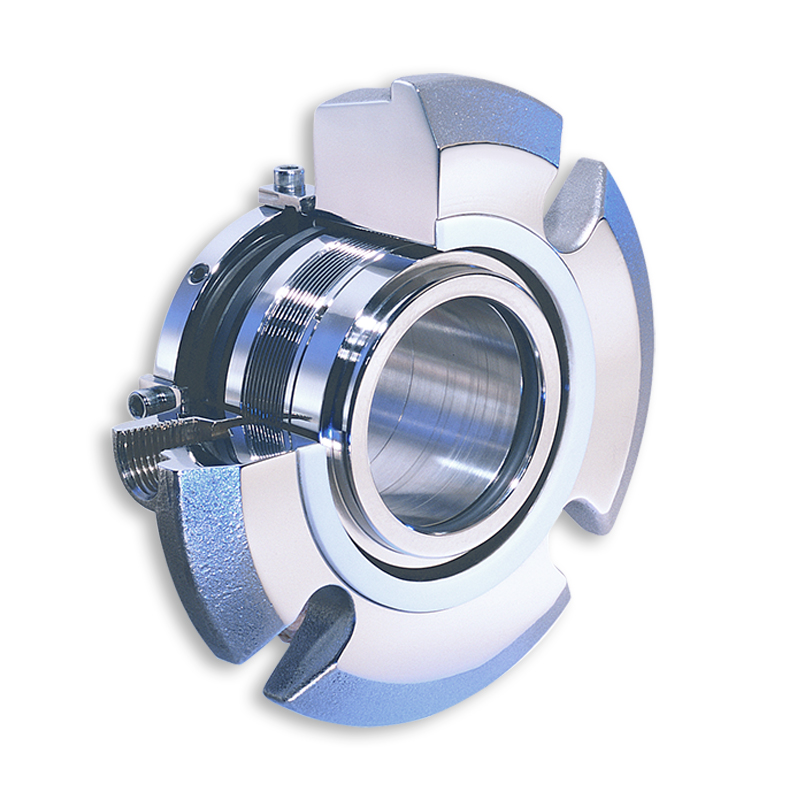
The definitions for seal orientations have been tweaked a bit in order to make those definitions more general. At first glance, this revision might seem to make the SealFAQs definitions differ from the API 682 definitions however, there really is no conflict. Note that although SealFAQs includes much information about API 682, SealFAQs is much more general. To save you a click or two, the revised definitions read
Although rotating springs are shown in the illustration above, the same definitions apply to seals having stationary springs or even to configurations mixing rotating and stationary springs.
The revised SealFAQs definitions now consider only the physical orientation of the seal rings and mating rings and not how the resulting configuration might be applied. This is a much more general approach than is used in API 682 but is not in conflict with API 682. In API 682:
The face-to-back configuration can be used for either Arrangement 2 or Arrangement 3 and has the barrier or buffer fluid on the ID of the inner seal and OD of the outer seal.
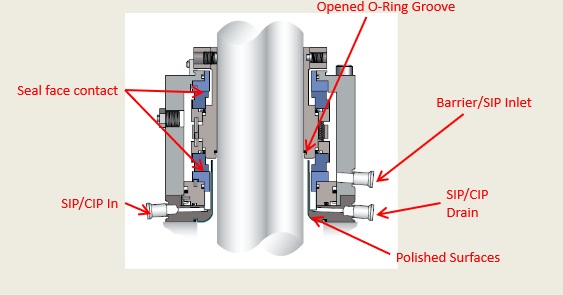
Pumps work hard to distribute fluid throughout elaborate systems. As a failsafe against leakage, pumps include one of two parts: packings or mechanical seals. While packing is a simple and inexpensive way to prevent fluids from leaking through their pumps, the packing material requires near-constant maintenance. Operators must keep packing lubricated, properly aligned, and sufficiently cool in order to keep a pump working smoothly. For this reason, more and more mechanical engineers are turning to mechanical seals to contain fluids that circulate through pumps.
A mechanical seal works by connecting to a pump’s rotating shaft and prevents the fluid a pump circulates from leaking around the impeller, which could damage the operations of the pump or process piping, as well as waste a precious fluid. At the same time, a mechanical seal also protects the fluid in question from adulterants or outside particles. For instance, dust or grit could inadvertently make its way into a delicate fluid, making it unacceptably abrasive.
Mechanical seals can be divided along several lines. In a previous entry, we examined how there are either balanced or unbalanced models, either spring-loaded seals or equipped with a bellows. There’s another angle to seal taxonomy—single versus double seals. While the initial impulse would be to believe a double seal is simply twice as effective, there’s more than meets the eye here. Ahead, we’ll go over some of the key differences between single and double mechanical seals. Allow us to compare and contrast these two approaches to mechanical seals for pumps and determine which model is right for your system and processes.
A single mechanical seal is composed of two faces and a mechanism that holds them in place—in a “pusher” seal, a spring, or in a “non-pusher” seal, a bellows. A very thin layer of the pump’s process fluid, sometimes measuring as narrow as a single micron, creates a film between the faces of the seal. Narrow as this film may be, it still provides two necessities to the operations of the seal. Not only does it work as a lubricant, but it also functions as a coolant. The moving parts of a pump can cause the seal’s temperature to rise, and this friction-generated heat can cause the seal to break down. Unlike packing, where a pumping system can function while it undergoes repairs, a system that relies on a mechanical seal necessitates a full shutdown in order to perform repairs. This makes minimizing such interventions imperative for engineers and operators.
As one would expect, a double mechanical seal is slightly more complex than its single-seal counterpart. In this component, there is a pair of seals working together in one piece of hardware. Each seal has a different purpose. The primary seal, the one that would be present in a single-seal configuration, is the “inboard” seal. The secondary seal is the “outboard” seal. The purpose of the inboard seal is to keep the fluid the pump is responsible for distributing contained within the housing of the pump. The outboard seal, on the other hand, prevents that fluid from exiting the system and entering the atmosphere.
Between them is a lubricant that goes by one of two names depending on its level of pressurization. When this lubricant is at a lower pressure than that of the pump’s fluid, we know it as a buffer liquid. A pressurized lubricant that separates the pump’s fluid from the atmosphere, however, is referred to as a barrier liquid. Popular buffer and barrier fluids include alcohol, propylene glycol, and petroleum products such as kerosene and diesel, though applications in which flammability is a concern necessarily contraindicate using any petroleum derivatives. In situations where boiling or freezing temperatures are not a concern, sometimes simple distilled water can serve as an ideal buffer or barrier liquid.
Just as a single seal has two faces, a double seal has four. Here, two faces are in rotation, while the other two remain stationary. This prolongs the life of the seal by concentrating wear upon the stationary faces while the rotating faces take less damage.
Double mechanical seals come in different configurations while providing additional protection to a pumping system. The most popular configuration is the “back-to-back” arrangement, in which a pair of rotating seal rings is set facing in opposite directions. The barrier liquid—in most cases, these call for a pressurized liquid—acts as a lubricant between them. Back-to-back double seals are prevalent in industries in which pumps work with dangerous chemicals. In handling these fluids, back-to-back seals are an effective bulwark against leakage. The barrier fluid simply absorbs any leakage and prevents it from entering the atmosphere. Less prevalent now is the “face-to-face” arrangement, which uses two pusher seals facing toward each other. This is still a popular choice in the food-processing industry, but is not popular when working with more hazardous media. The third common configuration is face-to-back, or “tandem.” A tandem arrangement allows for high volume and high pressure of the barrier liquid, while its outboard seal is a particularly valuable failsafe against pressure buildup, which prevents loss of the fluid in question to the atmosphere. Though a reliable design, the associated expenses of developing and maintaining a tandem seal have made the back-to-back configuration more popular in most respects.
You’ve been able to see some of the key differences between single and double mechanical seals. To sum it all up, let’s review:A single seal has two faces, while a double seal has four.
If your industrial processes could benefit from the added safety and performance of double mechanical seals over their simpler single siblings, Moley Magnetics has you covered with an extensive selection of industrial mechanical seals for your facility. Moley now partners with John Crane, the industry leader in pump seals, to provide smooth operations for our customers across diverse industries.




 8613371530291
8613371530291